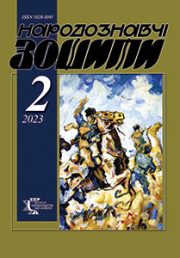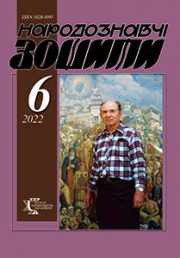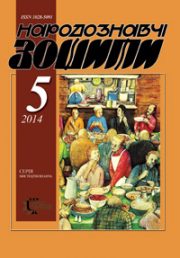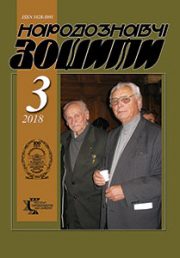The Ethnology Notebooks. 2022. № 4 (166), 850—867
UDK 398.2(=16):[398.7:393]
DOI https://doi.org/10.15407/nz2022.04.850
SENSE PAIR «SOMNIA — MORTEM» IN THE MYTHOLOGICAL PICTURE OF THE SLAVONIC WORLD
TEMCHENKO Andriy
- ORCID ID: http://orcid.org/0000-0003-3999-9459
- Candidate of Historical Sciences, Associate Professor,
- Associate Professor of the Department of the Ukrainian History
- of the Bohdan Khmelnytsky National University of Cherkasy,
- 81, boulevard of Shevchenko, 18000, Сherkasy, Ukraine,
- Contacts: e-mail: temchen@ukr.net
Abstract. Introduction. The semantic opposition «dream-death», which is interpreted in the context of the mythological ideas of the Slavs, is examined in the paper.
The purpose of the publication is to reconstruct the semantic features of the semantic pair «dream-death», which depend on specific cultural contexts — historical, mythological and social.
Research methods accumulate the means of scientific knowledge used in other Humanities, in particular in Linguistics, Philosophy, Psychology, Cultural Anthropology.
The results obtained. In the mythological picture of the Slavonic world, the «dream-death» opposition can be seen as a variant of the general semantic duality of life-death. Dreams with the dead are considered significant, which in their «structure» and «theme» resemble the mythological plots of the mythological hero’s journey to the afterlife. In this aspect, dreams are interpreted as a communicative channel that transmits information hidden from the uninitiated. Unlike other transitional states, in which the message «from there» is verbal, in dreams such a connection can be visual, in some cases tactile, which involves the dreamer’s automatic observance of certain rules governing the «format» of contact.
Of particular note are dreams that are interpreted as a warning of impending death or a dangerous disease. «Typical» motives are different in regulation and intensity of dreams with the participation of «messengers». Verbal or visual sessions are one-sided, i. e. the initiators of contact are representatives of «that» world. The function of «messengers» can be performed by relatives, acquaintances, imaginary people — living or dead, whose voices and images appear in a dream. In addition, dreams are considered significant, where cultural loci are visualized, which are classified in mythology as liminal.
An important factor shaping the cultural integrity of traditional society is the funeral meals or «sitting» near the deceased, during which a «new» biography of his «earthly» life was compiled.
Keywords: binary opposition, mountain, cemetery, bridge, myth, rite, deceased, messenger, burial, ritual, river, sacred, death, dream, temple.
Received 6.06.2022
REFERENCES
- Stavytska, Ya.V., & Skrypnyk, G.A. (Ed.). (2017). Prophetic Dream in the Narrative Structure of a Folk Tale. Slavonic world: yearbook (Issue 16). NASU; M.T. Rylsky IMPE. Kyiv. P. 148—172 [in Ukrainian].
- Stavytska, Ya.V. (2018). Oral Dream-Interpretive Narrative: Contextual-and-Functional Aspect. The dissertation on competition of a scientific degree of the candidate of Philological Sciences in specialty 10.01.07 «Folklore». M. Rylsky Institute of Art Study, Folklore and Ethnology National Academy of Sciences of Ukraine. Kyiv. Retrieved from: https://chtyvo.org.ua/authors/Stavytska_Yaryna/Usnyi_snotlumachnyi_naratyv_kontekstno-funktsionalnyi_aspekt/ (date of application: 26.04.2022) [in Ukrainian].
- Tsvetkova, A. Dream Images and Symbolic Forms of Culture. Retrieved from: https://cyberleninka.ru/article/n/obrazy-snovideniy-i-simvolicheskie-formy-kultury/viewer (date of application: 21.03.2022) [in Russian].
- Trebjesanin, Z. (2012). Stories about Dreams that Suggest Death and Dying and their Interpretation. Ethnoanthropological Problems, 3, 853—868 [in Bulgarian].
- Ivanauskaite, V. (2007). Samogitian Dreams: Folklore of Texts and Meaning of Contexts. Samogitian Folklore Research. Folklore. Works (Vol. XXXIV, pp. 79—96) [in Lithuanian].
- Robert, Moss (2010). The Secret History of Dreaming. New World Library; Gallery Books.
- Barbara, Tedlock. (Ed.). (1987). Dreaming and Dream Research (Р. 1—30). Dreaming: Anthropological and Psychological Interpretations; Cambridge University Press. Cambridge.
- Mary-T.B., Dombeck. Dreams and Professional Personhood: The Contexts of Dream Telling and Dream Interpretation among American Psychotherapists. Retrieved from: https://anthrosource.onlinelibrary.wiley.com/doi/epdf/10.1525/maq.1992.6.3.02a00120(date of application: 19.03.2022).
- Stewart C. (2004). Introduction: Dreaming as an Object of Anthropological Analysis. Dreaming, 14 (2—3),75—82. Retrieved from: https://psycnet.apa.org/doiLanding?doi=10.1037%2F1053-0797.14.2-3.75 (date of application: 15.03.2022).
- Eggan, D. (1952). ‘The Manifest Content of Dreams: A Challenge to Social Sciences’. In American Anthropologist (Vol. 54, pp. 469—485).
- Conversation of Three Saints. Collection. Retrieved from: http://litopys.org.ua/oldukr2/oldukr21.htm (date of application: 12.03.2022).
- Golosovker, Ya. (1987). Myth Logic. Moscow: Nauka [in Russian].
- Hervieu-Leger D., & Richard, K.Fenn. (Ed.). (2003). Individualism, the Validation of Faith, and the Social Nature of Religion in Modernity. The Blackwell Companion to Sociology of Religion (P. 161—175). Padstow: Blackwell Publishing Ltd.
- Naumovska, O. (2012). Correlation of Sleep with Death: Historical Background and Folk Tradition. Humanities Education in Technical Higher Educational Establishments, 26, 236—245. Retrieved from: https://jrnl.nau.edu.ua/index.php/go/article/view/7960 (date of application: 14.03.2022) [in Ukrainian].
- Chekan, O. (1993). Semantic Aspects of Polissya «Shouting». Folk Art and Ethnography, 4, 31—37. Retrieved from: https://elib.nlu.org.ua/view.html?&id=4550 (date of application: 03.03.2022) [in Ukrainian].
- Agapkina, T.A., Levkievskaya, E.E., & Toporkov, A.L. (Eds.). (2003). Polesye Conspiracies (in the Records of the 1970—1990s). Moscow: Indrik [in Russian].
- Chubynsky, P.P. (1995). The Wisdom of the Ages. Ukrainian Ethnography in the Creative Heritage of Pavlo Chubynsky: in 2 vol. (Vol. 1). Kyiv: Art [in Ukrainian].
- (1883). Materials for the Dictionary of the Old Russian Language According to Written Monuments. I.I. Sreznevsky’s Work. Edition of the Department of the Russian Language and Literature of the Imperial Academy of Sciences: in 3 vol. (Vol. 1). St. Petersburg: Printing house of the Imperial Academy of Sciences, 1883—1903 [in Russian].
- Fasmer, M., Trubachev, O.N., & Larin, B.A. (1986). Etymological Dictionary of the Russian Language: in 4 vol. (Vol. 1 (A—Д). Moscow: Progress [in Rissian].
- Markovych, O.V., Nomis, M., & Pazyak, M.M. (1993). Ukrainian Proverbs. Sayings and so on. Kyiv: Lybid [in Ukrainian].
- Bilodid, I.K., Dotsenko, P.P., & Yurchuk, L.A. (Eds.). (1971). Dictionary of the Ukrainian language: in 11 vol. (Vol. 2: Г—Ж). USSR Academy of Sciences; Institute of Linguistics. Kyiv: Naukova dumka [in Ukrainian].
- Hrinchenko, B. (Ed.). (1996). Dictionary of the Ukrainian language: in 4 vol. (Vol. 1: (A—Ж). Kyiv: Naukova dumka [in Ukrainian].
- Sidorov, A.S. (1997). Sorcery, Witchcraft and Corruption among the Peoples of the Komi. Materials on the Psychology of Witchcraft. St. Petersburg: Aleteyya [in Rissian].
- Florence, L. (2007). Askenazy, Karine Lestideau, Anne Meynadier, Emmanuelle Dor, Martine Myquel, Yves Lecrubier. Auditory Hallucinations in Pre-Pubertal Children. European Child & Adolescent Psychiatry. September (Vol. 16, pp. 411—415). Retrieved from: https://link.springer.com/article/10.1007/s00787-006-0577-9 (date of application: 26.02.2022).
- Fasmer, M., Trubachev, O.N., & Larin, B.A. (Eds.). (1987). Etymological Dictionary of the Russian Language: in 4 vol. (Vоl. 3 (Муза — Сят). Moscow: Progress [in Rissian].
- Kavinova, I.P. (2018). Mental Epidemic as a Social Phenomenon. Humanitarian Bulletin, 9, 1—17. Retrieved from: https://cyberleninka.ru/article/n/psihicheskaya-epidemiya-kak-sotsialnyy-fenomen/viewer (date of application: 26.02.2022) [in Rissian].
- Propp, V. Historical Roots of the Fairy Tale. Retrieved from: https://www.gumer.info/bibliotek_Buks/Linguist/Propp_2/04.php date of application: 04.03.2022) [in Rissian].
- Baiburin, A.K. (1983). Dwelling in the Ideas of the Eastern Slavs: monograph. Leningrad: Nauka [in Rissian].
- Kornienko, G. (1991). Order. Pedigree, 2, 8—13 [in Ukrainian].
- Sosenko, К. (1994). Cultural and Historical Figure of the Old Ukrainian Holidays of Christmas and Generous Evening. Kyiv: SINTO [in Ukrainian].
- Talanchuk, O.M. (Ed.). (1992). Recipes of Folk Medicine, Orders from the Disease (Written by J.P. Novytsky, P.S. Yefymenko, V.P. Myloradovych). Ukrainian Charms (P. 32—95). Kyiv: Lybid [in Ukrainian].
- Moudy, R. (1976). Life after Life. Study of the Phenomenon of Prolongation of Life after the Death of the Body. Retrieved from: https://lib.misto.kiev.ua/MOUDI/moudi.dhtml (date of application: 13.03.2022) [in Rissian].
- Fasmer, M., Trubachev, O.N., & Larin, B.A. (Eds.). (1986). Etymological Dictionary of the Russian Language: in 4 vol. (Vol. 2 (Е—Муж). Moscow: Progress [in Rissian].
- Toporkov, A.L. (1995). Bridge. Slavonic Mythology. Encyclopedic Dictionary (P. 267—268). Moscow: Ellis Luck [in Rissian].
- Trubachev, O.N. (1992). Ethnogenesis and Culture of the Ancient Slavs. Linguistic Research. Moscow: Nauka [in Rissian].
- Petrukhin, V.Ya. (1976). Burials of the Nobility of the Viking Age (according to Archeology and Literary Monuments) Scandinavian collection XXI. Tallinn: Eesti Raamat. Retrieved from: http://ulfdalir.narod.ru/literature/articles/burial.htm (date of application: 28.02.2022) [in Rissian].
- Petrukhin, V.Ya. (1980). The Burial Boat of the Vikings and the «Ship of the Dead» among the Peoples of Oceania and Indonesia (an Experience of Comparative Analysis). Symbolism of Cults and Rituals of the Peoples of Foreign Asia. Moscow: Nauka. Retrieved from: https://norse.ulver.com/articles/petruhin/deadship.html (date of application: 28.02.2022) [in Rissian].
- Skrypnyk, H.A., & Ivanytsky, A.I. (Eds.). (2012). Ukrainian Ceremonial Folklore of the Western Lands: Musical Anthology (Bessarabia. Boykivshchyna. Bukovyna. Volyn. Halychyna. Hutsulshchyna. Zakarpattia. Lemkivshchyna. Pidlyashshya. Podillya. Polissya. Pokuttya. Kholmshchyna). Vinnytsia: New Book. Retrieved from: http://folklor.ho.ua/Umf_www/books/uofzz/iv_uofzz.pdf (date of application: 26.02.2022) [in Ukrainian].
- Boldyrev, R.V., & Melnychuk, O.S. (Ed.). (2006). Etymological Dictionary of the Ukrainian Language: in 7 vol. (Vol. 5: Р—Т). Kyiv: Naukova dumka [in Ukrainian].
- Boldyrev, R.V., & Melnychuk, O.S. (Ed.). (2012). Etymological Dictionary of the Ukrainian Language: in 7 vol. (Vol. 6: У—Я). Kyiv: Naukova dumka [in Ukrainian].
- Toporov, V.N., & Lotman, Yu. (Ed.). (1969). To the Reconstruction of the Indo-European Ritual and Ritual-and-Poetic Formulas (on the Basis of Conspiracies). Proceedings on Sign Systems, ІV, 9—43. Tartu: Tartu state; University [in Rissian].
- Plotnikova, A.A., & Tolstoy, N.I. (Ed.). (1999). Cemetery. Slavonic Antiquities: Ethnolinguistic Dictionary: in 5 vol. (Vol. 2, pp. 503—507). Moscow: International Relations [in Rissian].
- Savitskaya, G.B. (2004). The Symbol of Life. Science and Life, 3, 63—66 [in Rissian].
- Tolstaya, S.M., & Tolstoy, N.I. (Ed.). (1999). Soul. Slavonic Antiquities: Ethnolinguistic Dictionary: in 5 vol. (Vol. 2, pp.162167). Moscow: International Relations [in Rissian].
- Davydyuk, V.F. (Ed.). (1993). Star Water (Secrets of Polissya Healers. Lutsk: Nadstyria [in Ukrainian].
- Dagmara, Staga. Post mortem, or On Polish Posthumous Photography. Retrieved from: https://culture.pl/ru/article/post-mortem-ili-o-polskoy-posmertnoy-fotografii (date of application: 12.09.2022) [in Rissian].
- Temchenko, A. (2019). The semantics of Bodily «Ttwins» in the Mythological Ideas of the Slavs. Folk Art and Ethnography, 3 (379), 25—35 [in Ukrainian].
- Baiburin, A.K., Bagno, V.E., & Novichkova, T.A. (Eds.). (1996). Polarities in Ritual (Hard and Soft). Polarity in Culture. Almanac «Eve» (Issue 2, pp. 157—165). St.-Petersburg [in Rissian].
- Safronov, Ye.V. (2009). Actualization of «Dream — Telling» in the Funeral and Memorial Rite (a Study of Ulyanovsk Region). Bulletin of the Russian State University for the Humanities. Series: Literature Study. Linguistics. Culturology (P. 159—167) [in Rissian].
- Temchenko, A.I. (2014). Traditional Orders: Semantic Transformations and Ritual Paradigms: Monograph. Cherkasy: IntroligaTOR [in Ukrainian].







